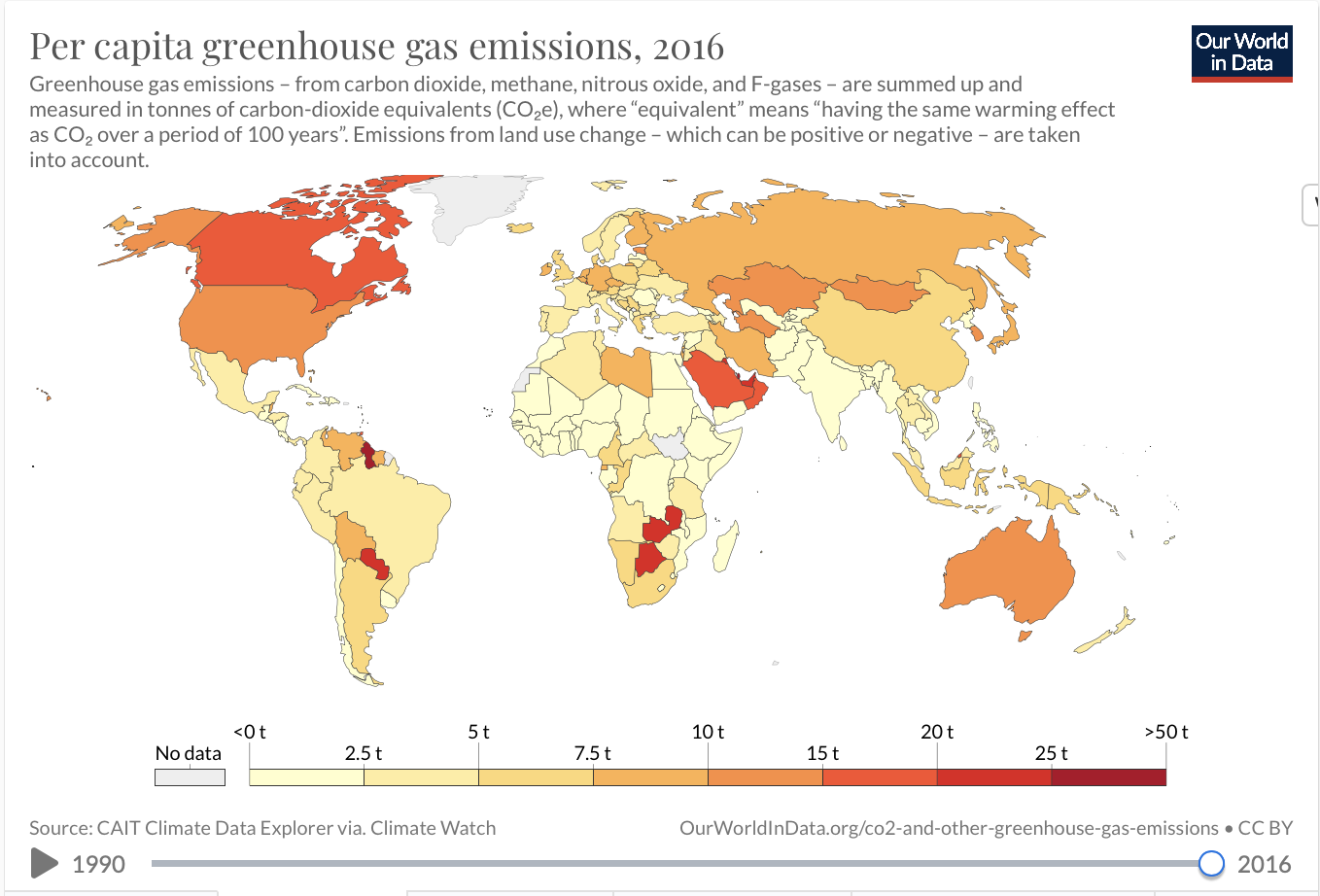Canada is warming twice as fast as the global average. And in the Canadian North it's three times.
Should we be worried?
I suppose Canadians will sit up and take notice once the permafrost turns squelchy and roads buckle and houses lean over at crazy angles.
But, until then, how do we grab their attention?
Walter Bauer sent me his latest research on Canada’s Greenhouse Gas Emissions (GHG) which got me thinking. Walter reviewed Canada’s two climate plans and the budget (links highlighted below) to see if GHG emissions were likely to reduce to anything near the Paris Agreement which, he admits, is a low bar.
By 2019 Canada’s GHG emissions had gone up to 730 mega-tonnes per year (Mt/year). I find it difficult to visualise this so I ask Walter for help. He tells me:
1 mega-tonne is 1 billion kilograms. An elephant weighs 4,000 kg. 1 mega-tonne equals 250,000 elephants.
Canada is emitting (2019 data) 730Mt of CO2 or 182,500,000 elephants every year.
Our World in Data is a very useful interactive website which allows you to rank Canada alongside any other country you care to mention. You can rank emissions per capita and in all sorts of other ways. (see graphic at the bottom) 
Walter Bauer writes:
"Canada’s baseline GHG emissions in 2005 were: 739 Mt/year and in 2016 (start of Liberal climate plans): 707 Mt/year. The reduction was primarily due to Ontario’s closing of coal-fired stations in 2014.
In his interview with CBC’s “The House”, Jonathan Wilkinson (Liberal Environment Minister) falsely took credit for early Ontario reductions and repeatedly referenced:
“sixty measures in the Pan-Canadian framework and an additional sixty-four in the Strengthened Climate Plan”.
Numbers are deceiving.

Through two climate plans and budget, the Liberals have introduced measures to counter Climate Change. This analysis subjectively divides the Liberal measures into four primary categories.
The focus of this review is any measure targeting a reduction in GHG emissions (green). Blue includes initiatives such as revised building codes or establishing standards. Grey includes Adaptation and Mitigation, Research & Development or vague commitments.
Pan-Canadian Framework (December 9/2016):: Goal, 511 Mt/year (30% below 2005 levels)

There were only eleven key measures (not 60) to reduce GHG emissions: $7.4 billion/year for 11 years.
GHG Emission Results as of 2019:
If the Pan-Canadian Framework had been effective, by 2019, Canada should have reduced its emissions to approximately 660 Mt/year (assumes linear reduction.) Instead, Canada’s emissions have gone up to 730 Mt/year. Apparently, Canada is the only member of the G-7 nations where emissions increased from 2015-2019. Emissions rose because key Liberal measures had no effect on:

During Question Period in Parliament, Jonathan Wilkinson said:
“2019 will be the last year Canada’s greenhouse gas emissions go up . . . We will see year-on-year reductions — absolute reductions — starting in 2020, through to 2030. We have high confidence that’s actually going to be the case.”
A Healthy Environment and a Healthy Economy (December/2020): Liberals projecting a reduction of emissions to 503 Mt/year (31% below 2005 levels), despite rise from 2016.
Despite the failures of the Pan-Canadian Framework, Canada increased its reduction target with its new climate plan.

There were an additional eleven key additional measures (not 64 additional) to reduce GHG emissions: an additional $2.5 billion/year for an average of 8 years.
Expected GHG Emission Results by 2022: (starting from 730 Mt/year in 2019)
-
-
-
- Temporary drop in GHG emissions in 2020 and 2021 due to pandemic (drop of 51 Mt/year);
- Enbridge Line 3 refurbishment complete in 2021 adding 23 Mt/year over 2019 levels;
- Trans Mountain pipeline will come on line in 2022 adding another 37 Mt/year over 2019 levels;
- Keystone XL pipeline (53 Mt/year) may yet be completed if Biden loses the next election;
- with zero-emission vehicles, even if we reduce emissions by 30% (unlikely), we will only save 50 Mt/year;
- if commercial/institutional and residential retrofits reduceemissions by 20% (unlikely) we will only save another 16 Mt/year; and
- if the Liberal climate plans were effective, by 2022, Canada should have reduced its emissions to approximately 620 Mt/year (16% below 2005 levels assuming linear reduction).Instead, the net result, not counting the temporary drop due to the pandemic or Keystone XL, is a reduction of 6 Mt (23 + 37 – 50 – 16) by 2022 or 724 Mt/year (a reduction of only 2% below 2005 levels.)
-
-
Budget (April 19/2021): Liberals projecting a reduction of emissions to 36% below 2005 levels.

Only three key additional measures to reduce GHG emissions: an additional $0.6 billion for 4 years.
2020 (reported in 2022) and 2021 emissions will show a decrease in GHG emissions but that is largely due to recessionary pressures created by the pandemic.
From 2023 to 2030, it is likely emissions will reduce “year-on-year” due to federal and provincial measures, however, nowhere near the levels required (likely only 10%-15% reduction below 2005 levels, we need 60%.)
Despite negligible GHG reductions to date and grim projections Trudeau announced on 22 April 2021 that Canada will reduce emissions to 40-45% below 2005 levels.
This email address is being protected from spambots. You need JavaScript enabled to view it.
Visit Our World in Data here.

